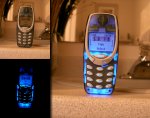Photo Compositing
 Photo compositing is the technique of taking two or more frame-aligned
photographs and combining them to produce a single well-balanced image.
Photo compositing is the technique of taking two or more frame-aligned
photographs and combining them to produce a single well-balanced image.
The compositing technique is used heavily in motion control photography, such as what was used on Star Trek in the days before computer animation. In that technique, several identical camera passes would be filmed:
- Beauty pass, showing the ship's in body in natural colour, lit as if by a star nearby;
- Light pass, where all is black except the window lights;
- Glow ("Malibu") pass, where only the glowing parts, such as futuristic engines, are visible;
- Strobe pass, where the strobing lights are filmed several frames on and several frames off;
- Mask pass, where the background is brightly lit and the object in the foreground is black.
The reason compositing is used rather than a single pass is to overcome the limitations imposed by contrast of the individual elements. For example, in reality, the interior lights of the Enterprise are very weak compared to the bright light used on the exterior for the beauty pass. When composed, one layer can be brightened independently of any other.
In the past, as with my Klingon D-7 model, I used manual compositing. Using low-ISO film, I would hold the shutter open for 10-15 seconds, to let the interior lights burn in nicely. During that time, a single flash, from the direction I wanted the beauty light from, was applied. The problem is that if the timing was at all badly balanced, the result would not look good, and the photograph would be wasted. It was luck as much as anything else. At the time, individual composite shots did not make much sense, as when scanning in the film, there is no way to ensure good alignment, and printing digital photographs was expensive.
Welcome to 2006. Digital cameras prove to be the ideal instrument for compositing. They have excellent light sensors, are not affected by frame misalignment, and can preview over- or under-exposure immediately.
This afternoon, I tested my theory using a typical automatic camera and my cell phone, which glows blue like the engines of the model I'm currently working on. The camera was locked down on a tripod, using a two-second timer to prevent misalignment when pushing the shutter button.
The top-left photo is the raw beauty frame, while the bottom-left is the raw light frame. Two minutes of compositing in the Gimp produced the image on the right. The glow can be increased or decreased at will. The experiment is successful, in that with normal lighting, the blue LEDs are hardly visible.
I'm excited that this technique is finally achievable without expensive equipment. It's not enough to build a good model if it cannot be photographed properly. I look forward to producing some amazing images later this year.
